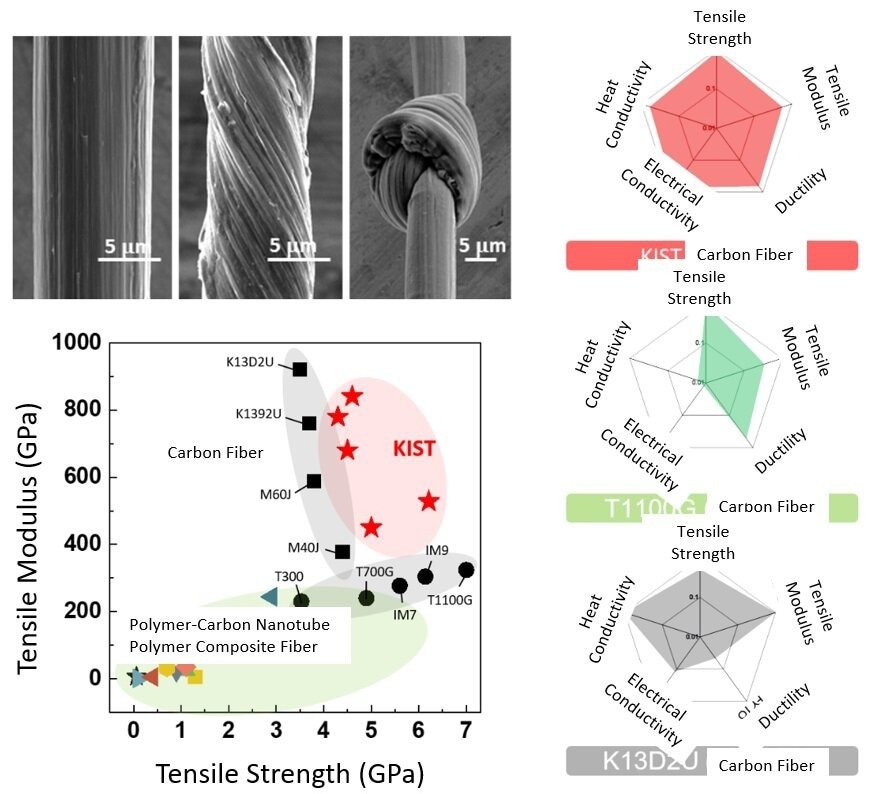Carbon nanotubes are a strong and lightweight material with high electrical conductivity, which could potentially surpass the performance of existing carbon fibers. However, producing fibers with these properties is challenging, and commercializing them is difficult due to the high cost of carbon nanotubes.

Comparison of carbon fibers and the high-strength/high-elasticity composite fiber consisting of polymer and carbon nanotubes. Credit: Korea Institute of Science and Technology
A recent study published in the journal Composites Part B: Engineering focuses on this issue by suggesting a liquid crystalline wet-spinning process as a means of producing polymer-carbon nanotube composite fibers that are highly oriented and possess superior modulus, strength, and electrical conductivity.
Carbon Fibers (CFs)
Carbon fibers are a type of material composed of thin strands of carbon atoms that have exceptional mechanical properties, including high strength, stiffness, and resistance to deformation. These properties make them highly sought after in many industries, including aerospace, defense, automotive, sports equipment, and renewable energy.
One of the most significant advantages of carbon fibers is their exceptional strength-to-weight ratio, making them an excellent choice for lightweight and high-strength applications. Carbon fibers also have excellent fatigue resistance, allowing them to withstand repeated loading cycles without breaking down. In addition, they exhibit high stiffness, which means they can resist bending and flexing without deforming.
Carbon fibers come in various forms, with each type exhibiting unique mechanical properties. For example, polyacrylonitrile (PAN) carbon fibers are known for their high strength, while pitch-based carbon fibers have high stiffness or modulus. There are also hybrid carbon fibers that combine the properties of both PAN and pitch-based fibers.
Use of Carbon Nanotubes in CFs
Carbon nanotubes (CNTs) are added to carbon fibers (CFs) to improve their mechanical properties. CFs are already known for their high strength and stiffness, but incorporating CNTs can further enhance these properties.
CNTs are incredibly strong and stiff themselves, and when they are added to the polymer matrix that makes up CFs, they can reinforce the structure and prevent cracks from forming. This can increase the tensile strength and modulus (stiffness) of the resulting composite material, making it more resistant to deformation and damage.
However, creating carbon fibers (CFs) using carbon nanotubes (CNTs) has proven to be a difficult task. One potential solution is to add carbon nanotubes (CNTs) to the polymer matrix of CFs, which has been shown to improve mechanical properties in recent studies. However, issues such as poor dispersion and limited amounts of CNTs in the polymer matrix need to be addressed.
Highlights of the Current Study
In this study, the researchers developed an economic fabrication technology for carbon nanotube-based composite carbon fibers.
To achieve this goal, the researchers proposed a novel process to fabricate wet-spun polyimide (PI)–CNT composite fibers and their CFs with high strength and modulus.
The solvent used in this process is camphorsulfonic acid (CSA), which has extremely high acidity and readily protonates aromatic hydrocarbons. As a result, it encourages the disintegration of different polymers that include aromatic groups. Moreover, the CSA functions as a polar solvent, dissolving polymers with polar functional groups like carboxylic acids, alcohols, and amines in their protonated state.
To create the composite fibers, the researchers effectively dispersed the CNTs and the polymer in CSA without physical or chemical treatment. This allowed for the hybridization of CNTs and the polymer. High-performance fibers were obtained by wet-spinning without high-temperature heat treatment.
The research team successfully developed composite fibers with high modulus and high strength. The fibers were created using a continuous wet spinning process, followed by a high-temperature heat treatment. The team was able to achieve a modulus of 528 GPa and a strength of 6.2 GPa. These properties were found to be 1.6 times higher than those of commercially available fibers, which have a modulus of approximately 320 GPa.
The microstructure analysis revealed that a reduction in the internal void of the fibers enhanced their physical properties.
The carbon nanotube/polyimide compound also enhanced the orientation of the carbon nanotubes. It was observed that replacing up to 50% of the carbon nanotubes with low-cost polyimide helped to lower the overall cost without compromising the mechanical properties of the fibers.
The proposed manufacturing process can create composite fibers and CFs (carbon fibers) with high strength and modulus. Using low-cost polyimide in the manufacturing process could lead to more affordable high-strength fibers, making them accessible to a wider range of industries and applications.
"This research is meaningful because the fabrication cost of carbon-nanotube-based carbon fibers can be greatly reduced by using low-cost polymers." said Dr. Ku, a co-author of the study,
These novel carbon fibers, which used to be difficult to commercialize due to high cost, are expected to be used in the aerospace, military, and future mobility industries.
Bon-Cheol Ku, Co-Author, KIST
Reference
Kim, S.G. et al. (2022). Ultrahigh strength and modulus of polyimide-carbon nanotube based carbon and graphitic fibers with superior electrical and thermal conductivities for advanced composite applications. Composites Part B: Engineering. Available at: https://doi.org/10.1016/j.compositesb.2022.110342
Disclaimer: The views expressed here are those of the author expressed in their private capacity and do not necessarily represent the views of AZoM.com Limited T/A AZoNetwork the owner and operator of this website. This disclaimer forms part of the Terms and conditions of use of this website.
Source:
: National Research Council of Science & Technology